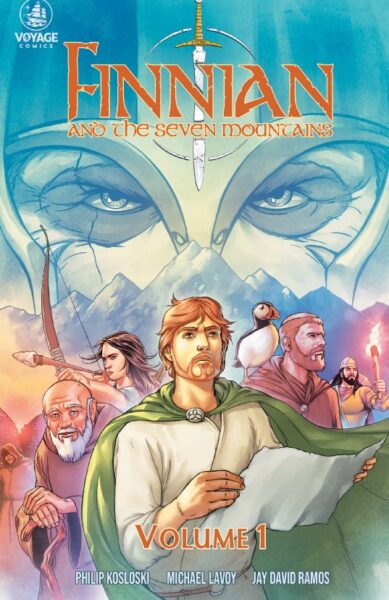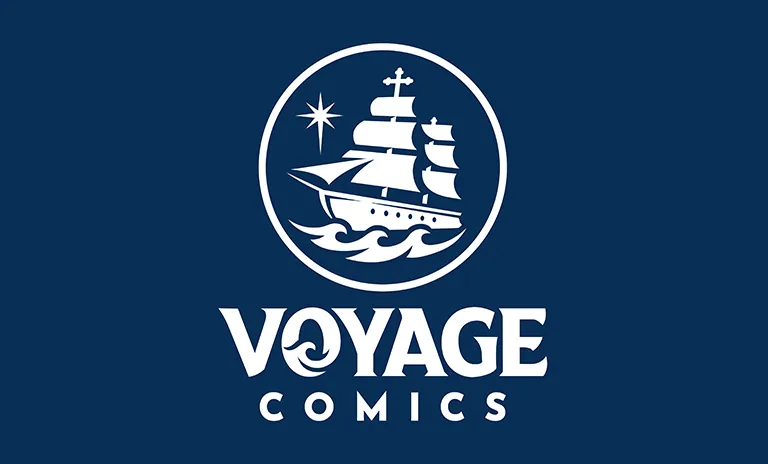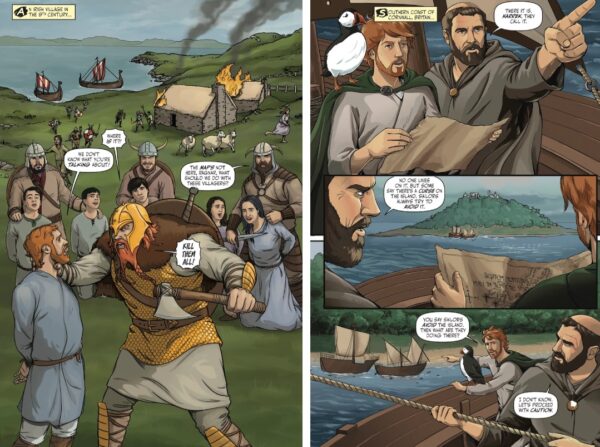Review: Finnian and the Seven Mountains
 Finnian and the Seven Mountains: Voyage Comics
Finnian and the Seven Mountains: Voyage Comics
I first became acquainted with Voyage Comics last year when I saw a display they had set up at the Minnesota Catholic Home Education Conference and Curriculum Fair in 2023. They were promoting their new comic series Finnian and the Seven Mountains. I got to meet some of the fine people involved in the project and talk about the art of comic making. The promotional material for Finnian looked great, and I was delighted to see the folks at Voyage had chosen an Irish hero from Ireland’s golden age to be the story’s protagonist.
Recently, Philip Kosloski at Voyage was kind enough to provide me with complimentary copies of Finnian and the Seven Mountains. And let me say, I was thrilled when I opened the package and saw these beautiful books.
Graphic novels are popular these days, and sometimes you get the sense that publishers are churning out graphic novels just because it’s a fad—because “it’s what the kids are into.” Some will push content into graphic novel form without a real understanding of the elements that make a graphic novel successful. Not so with Voyage Comics. The people behind Voyage clearly love the comic book medium and understand it. This really shines through in every artistic and editorial choice the creators of Finnian made. I really felt like I was reading a real comic, not just content masquerading as a comic.
Sword of St. Michael
Set in the 9th century, Finnian and the Seven Mountains tells the story of an Irishman named Finnian whose family has been killed by the Vikings. Grappling with the grief of his loss, Finnian embarks upon a quest to find the Sword of St. Michael, a legendary weapon reputed to have the power to vanquish any evil. His adventure will pit him against the cruel Viking warlord Ragnar, a bloodthirsty marauder who wants the sword for his own wicked purposes.
Finnian’s adventures are structured around the legend of the so-called Sacred Line of St. Michael, a ley line connecting seven historic shrines to St. Michael the Archangel stretching from Ireland’s Skellig Michael to Stella Maris Monastery on Mount Carmel. We travel to many wonderful locations, from Ireland to France, Italy, Greece, and finally to the Holy Land.
The Art of Storytelling
I really want to praise Kosloski’s storytelling here, for he weaves a fantastic tale. Finnian draws deeply from early medieval folklore (and there is a lot to draw from!). It also does not shy away from incorporating fantasy elements—our heroes encounter gargoyles, goblins, dragons, undead, and all manner of fiendish creatures along their journey. There is a visit to Atlantis, supernatural weapons, and ancient demons. Finnian is thus not so much a historical tale as a fantasy tale woven around the legends of early medieval Europe. This is part of its charm; when reading Finnian, I felt immersed in the world the way a 9th century Europeans saw it, a place full of monsters and prodigies, miracles and mysterious powers.
I particularly enjoyed Kosloski’s notes at the end of each book explaining his inspirations, which were as diverse as ancient St. Michael legendaria, J.R.R. Tolkien, the Old Testament, and (if I am not mistaken) I think I even discerned a bit of Star Wars in there. The result is an eclectic smorgasbord of influences and imagery that feels like going on a D&D adventure, complete with the protagonist who picks up a party of mismatched companions that, by the end, learn to function as a team. So, in terms of storytelling and thematic imagery, I give Finnian 100%.
Catholic Fiction
I also appreciated that Finnian wasn’t afraid to get dark at moments. I have often been annoyed by Catholic fiction that is too saccharine, too sanitized, too timid. And while there’s a place for that sort of writing, I have always appreciated Catholic fiction that is not afraid to shy away from exploring the darker aspects of human nature. One reason The Lord of the Rings is so compelling is because Sauron and his minions are really bad. The sheer evil of the villain creates stakes that keep us vested in the hero’s success and make the story more compelling.
Similarly, Finnian isn’t afraid to show the brutality of the ninth century, both the historical and the fantastical. Viking massacres, human sacrifice, summoning the dead, and engagement with ancient demons all figure into the story. But this is admirably balanced by the series’ bright spots and spiritual lessons: the power of God over the darkness of the enemy, the importance of virtues such as honesty and perseverance, and the belief that, ultimately, the unfolding of events is governed by God’s inscrutable Providence.
I thoroughly enjoyed Finnian and the Seven Mountains in every respect. The art, story, and messaging were all spot on. And with two books spanning seven volumes, it was substantial enough that it took me a few days to get through, which was perfect. I had difficulty putting these books down once I took them up, which is always a testimony to a compelling work. It’s clear that Philip Kosloski and his team are interested, first and foremost, in telling a good story. He clearly loves the traditions, history, and imagery of this period in history, which shows in every panel.
Conclusion
In my opinion, this is what separates great writers of Catholic fiction from those who are merely serviceable. The former, first and foremost, want to tell a good story, and because they are Catholic, their Catholicism bleeds into the story through the subject matter, images, and themes. The latter starts with wanting to hammer home a Catholic message and are forced to construct a story around it, which generally means the story suffers at the expense of the messaging—and hence neither the story nor the message lands. It’s so refreshing to see a Catholic work like Finnian and the Seven Mountains that understands the mechanics of good storytelling.
I should mention that Voyage’s website gives you the option of buying all seven books in two volumes or each individual book separately.
I recommend getting a copy of Finnian and the Seven Mountains. As for age suitability, I’d say ten-years old and up. I also have a copy of Voyage’s The Mission of St. Joan of Arc that I will be digging into shortly, so stay tuned for more!
If you’d like to continue the discussion and share your favorite books, I invite you to join me and other parents at our Homeschool Connections Community or our Facebook group.
Lastly, Homeschool Connections offers a wide variety of online courses for 3rd to 12th grade to help you homeschool. See our Course Finder to learn more.







